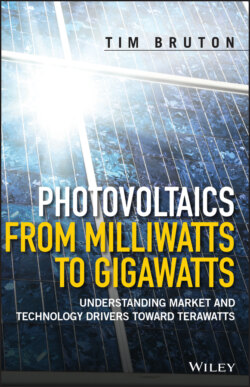Читать книгу Photovoltaics from Milliwatts to Gigawatts - Tim Bruton - Страница 23
1.4.2 Multijunction Solar Cells for Space
ОглавлениеThe first successful GaAs heterojunction solar cell was demonstrated in 1970 for a GaAlAs/GaAs structure [71]. Good progress was made, and by 1981 an AM0 efficiency of 15% was posted for a GaAs/GaAlAs tandem [72]. At the same time, it was observed that germanium could also be used as a substrate, as it is also lattice matched to GaAs, as shown in Figure 1.12 [67]. At this point in time, liquid‐phase epitaxy was the preferred method for making the tandem cells. Lattice matching is important as if a significant mismatch occurs, the stress at the interface between two semiconductors creates threading dislocations which spread through the epitaxial layers and act as recombination centres. These have a great impact in reducing the solar cell efficiency. Removing the lattice‐matching constraint means a wider range of III–V compounds can be used, with greater potential for high efficiency. In this case, alternating layers with different lattice parameters of stress and compression can prevent the generation of threading dislocations. These are known as metamorphic cells [64]. In general, space cells have been lattice matched, but metamorphic cells have been developed for concentrator applications. A particular challenge with the use of tandem cells is that there is a p/n junction between the top cell and the bottom one, which is rectifying for the direction of current flow. To overcome this, a heavily doped ‘tunnel junction’ is used, in which carriers can travel through the rectifying junction, as illustrated in Figure 1.14 [73]. The requirements of the tunnel junction are that it be a wide‐bandgap semiconductor for good transparency and that it be heavily doped in order for tunnelling to occur. This makes for an added complexity and cost for tandem cells.
Figure 1.14 (a) Structure of a tandem cell, showing the tunnel junction.
Source: N.J. Ekins‐Daukes: in “Solar Cell Materials‐Developing Technologies” ed G J Conibeer and A Willoughby. Pub J Wiley (2014) 113‐143
(b) Associated band diagram, highlighting the tunnelling effect [73]
(Courtesy Wiley) Source: N.J. Ekins‐Daukes: in “Solar Cell Materials‐Developing Technologies” ed G J Conibeer and A Willoughby. Pub J Wiley (2014) 113‐143
As already described, the availability of MOCVD deposition systems greatly assisted the development of III–V epitaxial growth. By 1995, the practical limit for a GaInP2/GaAs tandem cell of 30% was reached [74]. At the same time, efforts were underway to fabricate III–V cells for use in space. Germanium was preferred to GaAs as the substrate, as it was physically much more robust. Initially, it was only used as an inactive substrate, but its low bandgap at 0.7 eV made it ideal for use as the bottom cell in triple‐junction tandem. Initial production of single‐junction GaAs/Ge cells was reported in 1990, with AM0 spectrum cells achieving 18% efficiency for a 4 × 2 cm cell [75].
Figure 1.15 Structure of a very high‐efficiency triple‐junction tandem III–V solar cell [78]
(Courtesy Wiley) Source: H. Yoon et al: Progress in Photovoltaics‐Research and Applications. 13 (2005) 133–139
By 1996, double cells were being made with GaAs/Ge, and a best cell with an efficiency of 23.8% was reported [76]. At the same time, results were being published for triple‐junction GaInP2/GaAs/Ge cells with an efficiency of 25.7% (4 cm2) [77]. The first commercial satellite with dual‐junction cells was launched in 1998, with initial cell efficiencies of 22%. By 2005, triple‐junction cells with an initial efficiency of 28.0% (AM0 spectrum) were being manufactured [78]. The structure of a triple‐junction solar cell is depicted in Figure 1.15, which shows the complexity of the device structure. The current best efficiencies being manufactured for use in space belong to triple‐junction cells, at 32% at beginning of life and a projected 30% after 15 years’ space exposure [79]. Figure 1.16 shows the assembly of current solar panels for use in space.
